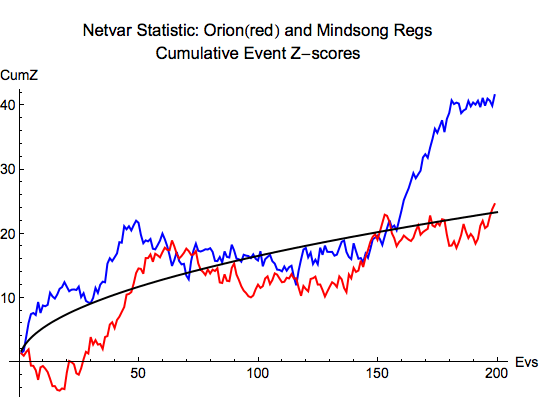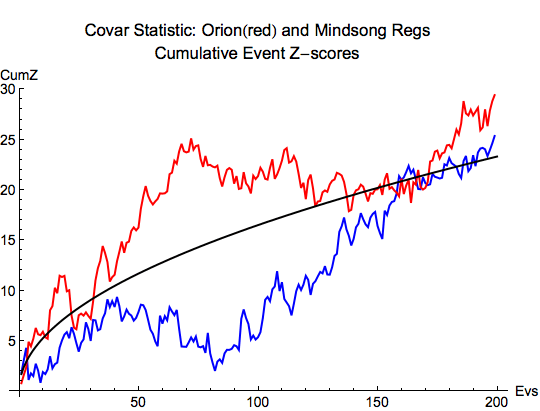We are sometimes led to new insights as a side effect of
questions about different matters. For example, although our
standard prediction for effects in the netvar statistic is a
positive change, we have seen a tendency to negative-going
netvar trends for some kinds of events, notably a subset of large,
organized meditations. Looking for mechanisms
that could help explain the sign of deviations requires
delving into the generation of the bit sequences we sample
at a basic level. One aspect of that is the use of a logical
XOR operation to eliminate bias of the mean. The question
is, how might this XOR affect the eventual bit sums we
record. There are two types of XOR employed, one with an
alternating bit-stream, and one that is a more complicated
mask consisting of the (ramdomized) sequence of all bytes
with an equal number of 1 and 0 bits.
This is Peter's description of recent, suggestive work:
In the last email, I showed that IF the netvar deviation is
driven by a short-lag autocorrelation, the deviation's sign
will depend on the autocorr's sign. Furthermore, the effect
of the XOR on the autocorr is simply to flip the sign of the
deviation: XOR'd, positive autocorrelations at the bit level
yield a negative trend in the netvar and visa-versa. While
speculative as a model, it at least gives one *possible*
explanation for pk-like deviations coupling to the netvar
with a preferential sign: it's potentially due to the sign
of an underlying autocorrelation. Netvar trends with
positive or
negative slope would then imply bit-level autocorrelations of
one sign or the other.
The result is qualitative. We need to ask if it maintains
for the XOR masks we have in place in the network. This
bears looking into since the Orion and Mindsong masks are
very different. Do the different masks imply different
filters for an autocorrelation? Does any difference come
through if we look at the two reg types separately across
the events?
It turns out that the two masks "pass" an autocorrelation
quite differently. The Orion 010101... mask cancels a
long-lag autocorrelation efficiently, but a lag-1
autocorrelation perfectly matches the mask and is passed
(albeit with the deviation's sign inverted wrt the
autocorr's). The Mindsong, being 560 bits long before
repeat, cancels short-lag autocorr's, but begins to pass
autocorrelations more and more as the length of the lag
increases.
Question: can the reg's different filtering characteristics
be consistent with what we see in the event data? The short
answer is yes. What we observe is that the netvar event
cumdev is pretty much the same if we look at *only* mindsong
regs or *only* orion regs (I've done this, but I don't know
if you've seen this analysis by reg-type; see plots). So the
question becomes, is there an autocorrelation for which the
response is roughly the same for both reg types? It turns
out that an exponentially decaying autocorrelation does it.
This is nice since it is also the best guess model for any
simple autocorrelation affecting reg behavior. A quick look
suggests that an autocorr decaying over a lag of 10 to 20 bits
balances the reponses fairly well.
There are some more details - such as what's happening to
the covar - but I won't go into it all now. The bottom line
is that *if* we ask how can the netvar go sometimes positive and
sometimes negative, one answer is that a simple exponentially
decaying autocorrelation at the bit level can do it, *and*,
if this were the case, it would also be consistent with some
important aspects of the internal structure we see in the
event data.



